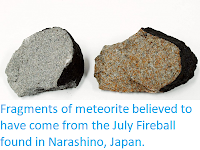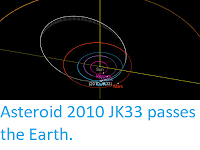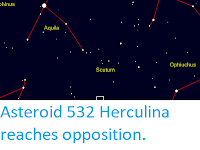Asteroid 2 Pallas will reach opposition, the point at which it is
more-or-less directly opposite the Sun when observed from the Earth (since 2 Pallas does not orbit in the Plane of the Eliptic, it is in fact some way north of directly opposite Earth at opposition), at 7.10 pm GMT
on Wednesday 15 July 2020, when it will also be 1.23 AU (i.e. 1.23 times as far from the
Earth as the Sun, or about 184 140 000 km), and be completely
illuminated by the Sun. While it is not obvious to
the naked eye observer, asteroids have phases just like those of the
Moon; being further from the Sun than the Earth, 2 Pallas is 'full'
when
directly opposite the Sun. As 2 Pallas is only about 272.5 km in
diameter, it will not be visible to the naked eye, but with a maximum
Apparent Magnitude (luminosity) of 9.64 at opposition, it should be
visible in the Constellation of Sagitta to viewers equipped with a good pair
of binoculars or small telescope.
The orbit and current position of 2 Pallas. The Sky Live 3D Solar System Simulator.
2 Pallas was discovered on 5 April 1779 by the French astronomer Charles Messier. It was recognised as being a small body orbiting between Mars and Jupiter by Heinrich Olbers in 1802, the year after Asteroid 1 Ceres was discovered by Carl Gauss. The discovery of these two small bodies in an area where a planet had been predicted eventually led to the discovery of the Main Asteroid Belt in the min nineteenth century. The name Pallas derives from Pallas Athena, an alternative name for the Greek goddess Athena.
Very Large Telecope image of 2 Pallas made on 4 December 2017. Paranal Observatory/European Space Agency/Wikimedia Commons.
2 Pallas has an 1687 day (4.62) orbital period and an eccentric orbit
tilted at an angle of 34.8° to the plane of the Solar System, which
takes it from 2.13 AU from the Sun (i.e. 213% of the the average
distance at
which the Earth orbits the Sun) to 3.41 AU from the Sun (i.e. 341% of
the
average distance at which the Earth orbits the Sun). As an asteroid that
never comes within 1.666 AU of the Sun and has an average orbital
distance less than 3.2 AU from the Sun, 532 Herculina is classed as a
Main Belt Asteroid.
The position of 2 Pallas at opposition. Heavens Above.
See also...
Follow Sciency Thoughts on Facebook.









